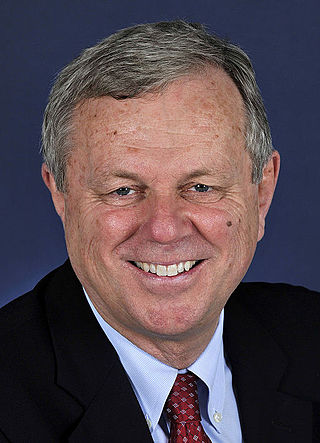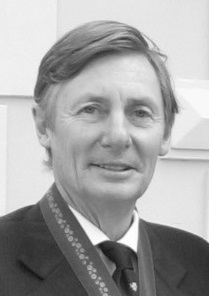
Michael David Rann,, is an Australian former politician who was the 44th premier of South Australia from 2002 to 2011. He was later Australian High Commissioner to the United Kingdom from 2013 to 2014, and Australian ambassador to Italy, Albania, Libya and San Marino from 2014 to 2016.
Dean Craig Brown, AO is a politician who served as the Premier of South Australia between 14 December 1993 and 28 November 1996, and also served as 10th Deputy Premier of South Australia between 22 October 2001 and 5 March 2002, representing the South Australian Division of the Liberal Party of Australia. He became premier when he led the party to a landslide win at the 1993 state election, and lost the office when he lost a leadership challenge to John Olsen in November 1996.

John Wayne Olsen, AO is an Australian former politician, diplomat and football commissioner. He was Premier of South Australia between 28 November 1996 and 22 October 2001. He is now President of the Federal Liberal Party, Chairman of the Australian American Association, Chairman of the Adelaide Football Club and Deputy Chairman of the Adelaide Oval Stadium Management Authority.
Robert Gerard Kerin is a former South Australian politician who was the Premier of South Australia from 22 October 2001 to 5 March 2002, representing the South Australian Division of the Liberal Party of Australia. He was also Deputy Premier of South Australia from 7 July 1998 until he became Premier and, after losing government, leader of the opposition until after the 2006 election.

The state election for the 51st Parliament of South Australia was held in the Australian state of South Australia on 18 March 2006 to elect all members of the South Australian House of Assembly and 11 members of the South Australian Legislative Council. The election was conducted by the independent State Electoral Office.

Elections for the 54th Parliament of New South Wales were held on Saturday, 24 March 2007. The entire Legislative Assembly and half of the Legislative Council was up for election. The Labor Party led by Morris Iemma won a fourth four-year term against the Liberal-National coalition led by Peter Debnam.

State elections were held in South Australia on 9 February 2002. All 47 seats in the South Australian House of Assembly were up for election, along with half of the 22 seats in the South Australian Legislative Council. The incumbent Liberal Party of Australia led by Premier of South Australia Rob Kerin was defeated by the Australian Labor Party led by Leader of the Opposition Mike Rann. The Labor Party won 23 out of 47 seats, and then secured the one more seat it needed for a majority by gaining the support of independent Peter Lewis.

Robert Bruce Such was a South Australian politician. He was the member for the seat of Fisher in the South Australian House of Assembly from 1989 until his death in 2014. He defeated Labor MP Philip Tyler at the 1989 election and was a member of the Liberals until 2000 when he became an independent. Such was Minister for Employment, Training and Further Education, and Minister for Youth Affairs, in the Brown Liberal government from 1993 to 1996. He served as Speaker of the South Australian House of Assembly for the Rann Labor government from 2005 to 2006. Such was joint Father of the House with Michael Atkinson from 2012.
Rory John McEwen is a former Australian politician who was the independent member for the seats of Gordon (1997–2002) and Mount Gambier (2002–2010) in the South Australian House of Assembly.
State elections were held in South Australia on 11 December 1993. All 47 seats in the South Australian House of Assembly were up for election. The incumbent Labor government, led by Premier Lynn Arnold, was defeated by the Liberal Opposition, led by Dean Brown, in a landslide victory. The Liberals won what is still the largest majority government in South Australian history.

State elections were held in South Australia on 25 November 1989. All 47 seats in the South Australian House of Assembly were up for election. The incumbent Australian Labor Party led by Premier of South Australia John Bannon defeated the Liberal Party of Australia led by Leader of the Opposition John Olsen. Labor won 22 out of 47 seats, and secured a majority of 24 with the support of two Independent Labor members.

State elections were held in South Australia on 7 December 1985. All 47 seats in the South Australian House of Assembly were up for election. The incumbent Australian Labor Party led by Premier of South Australia John Bannon increased its majority, and defeated the Liberal Party of Australia led by Leader of the Opposition John Olsen.

State elections were held in South Australia on 6 November 1982. All 47 seats in the South Australian House of Assembly were up for election. The incumbent Liberal Party of Australia led by Premier of South Australia David Tonkin was defeated by the Australian Labor Party led by Leader of the Opposition John Bannon.

Elections to the 52nd Parliament of New South Wales was held on Saturday, 27 March. All seats in the New South Wales Legislative Assembly and half the seats in the New South Wales Legislative Council was up for election. The New South Wales Premier Bob Carr won a second term with a 7% swing of vote against the Liberal National Party Kerry Chikarovski. The poll was the first to be held after two key changes to the electoral system. In 1997, the number of electoral districts was reduced from 99 to 93. In 1995, fixed four-year terms were introduced. As of 2023, this is the most recent NSW election in which the leader of the winning party would complete a full term as Premier.

The 2010 South Australian state election elected members to the 52nd Parliament of South Australia on 20 March 2010. All seats in the House of Assembly or lower house, whose current members were elected at the 2006 election, and half the seats in the Legislative Council or upper house, last filled at the 2002 election, became vacant.

The 2014 South Australian state election elected members to the 53rd Parliament of South Australia on 15 March 2014, to fill all 47 seats in the House of Assembly and 11 of 22 seats in the Legislative Council. The 12-year-incumbent Australian Labor Party (SA) government, led by Premier Jay Weatherill, won its fourth consecutive four-year term in government, a record 16 years of Labor government, defeating the opposition Liberal Party of Australia (SA), led by Opposition Leader Steven Marshall.
The 1993 South Australian state election was held on 11 December 1993.

The Rann government was the state executive government of South Australia led by Premier of South Australia Mike Rann of the South Australian Branch of the Australian Labor Party (ALP) from 2002 to 2011.

The South Australian Labor Party, officially known as the Australian Labor Party (South Australian Branch) and commonly referred to simply as South Australian Labor, is the South Australian Branch of the Australian Labor Party, originally formed in 1891 as the United Labor Party of South Australia. It is one of two major parties in the bicameral Parliament of South Australia, the other being the Liberal Party of Australia (SA Division).

The South Australian Liberal Party, officially known as the Liberal Party of Australia (South Australian Division), is the South Australian Division of the Liberal Party of Australia. It was formed as the Liberal and Country League (LCL) in 1932 and became the South Australian Division of the Liberal Party when the Liberal Party was formed in 1945. It retained its Liberal and Country League name before changing to its current name in 1974. It is one of two major parties in the bicameral Parliament of South Australia, the other being the Australian Labor Party (SA Branch). The party has been led by Leader of the Opposition David Speirs since the 2022 state election after a one-term government.















